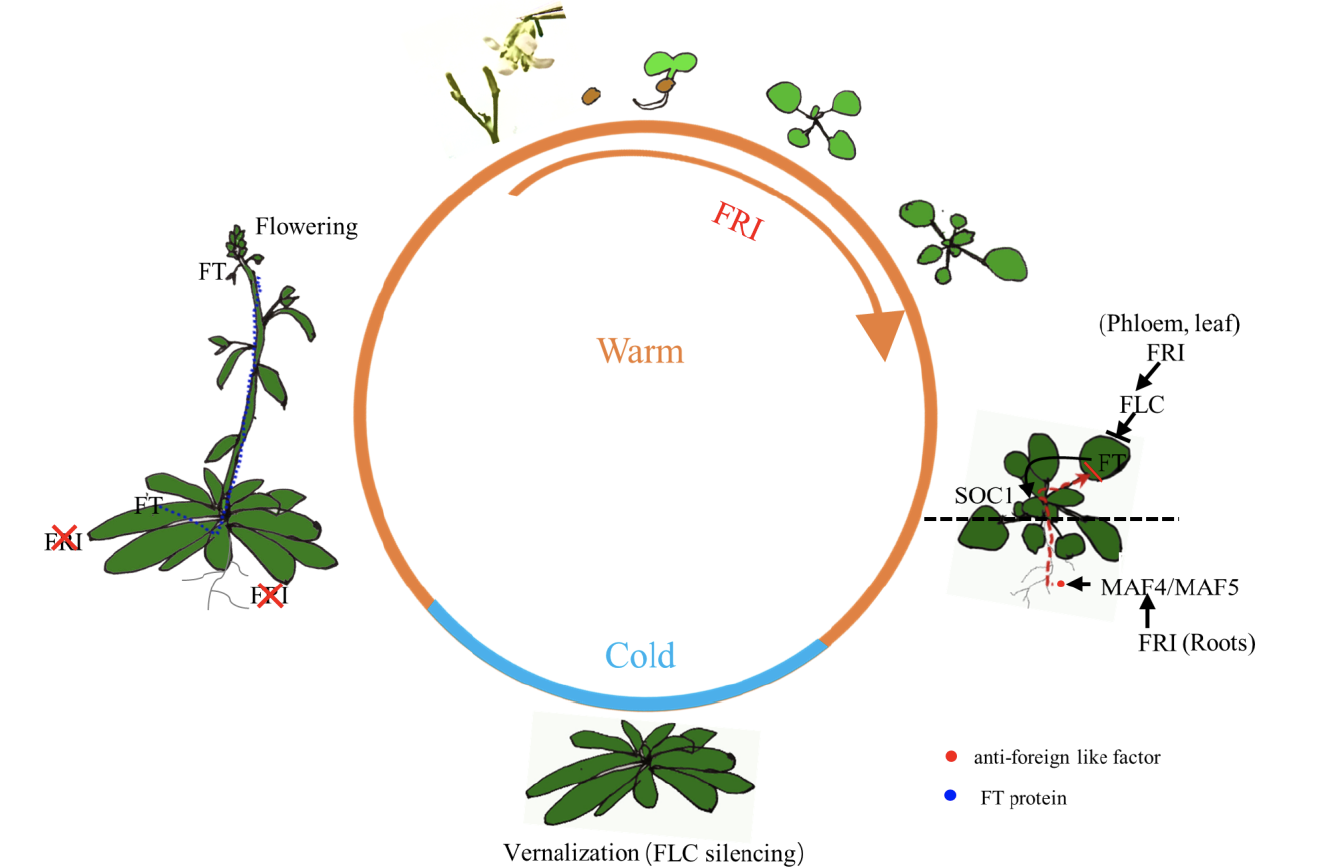博文
J EXP BOT:拟南芥根中表达FRI基因延迟植株开花
||
Expression of FRIGIDA in root inhibits flowering in Arabidopsis thaliana
First author: Xiangxiang Kong; Affiliations: CAS Kunming Institute of Botany (中科院昆明植物研究所): Kunming, China
Corresponding author: Xiangyang Hu
FRIGIDA (FRI) as the major regulator of flowering time in Arabidopsis accessions can activate its target FLOWERING LOCUS C (FLC) to delay flowering before vernalization. Besides FLC, other FRI targets also exist in Arabidopsis. Although leaves sense environmental cues to modulate flowering time, it is not known if roots also regulate the floral transition. In this study, we investigated the spatiotemporal effect of FRI on flowering time. Local expression of FRI in the phloem and leaves activated FLC to delay flowering. Furthermore, we found that local expression of FRI in the roots also delayed flowering by activating other targets MADS AFFECTING FLOWERING4 (MAF4) and MAF5 in the roots. Graft and genetic experiments revealed that the spatial expression of FRI in the root might generate a mobile signal, which is transmitted from roots to shoot and antagonizes the FT signal to delay flowering. Specifically expressing FRI in the embryo efficiently delayed flowering, even expressing FRI as early as pro-embryo stage is enough to upregulate FLC expression to delay flowering. Together, our findings confirm the spatiotemporal effect of FRI on delaying flowering, and propose that root tissue also perceives the flowering signal to fine-tune the flowering time through MAF4/5 as novel targets of FRI.

FRIGIDA基因是拟南芥不同品种开花时间调控的主要因子,其可通过激活靶基因FLC在春化之前延迟开花。除了FLC之外,FRI在拟南芥中还存在其他的靶基因。尽管植物的叶片可以感知环境信号来调控开花时间,但植物的根是否对于成花转变具有调控作用还不清楚。本文中,作者研究了FRI的时空表达对于开花时间的影响。FRI基因在韧皮部和叶片中表达能够激活FLC,从而延迟开花。此外,作者发现FRI在根中表达同样能够延迟开花,不过其在根中的靶基因是MAF4和MAF5。嫁接和遗传学试验显示FRI基因在根中的表达可能会产生一个移动信号,该信号会从根中传递到地上组织,并且与FT信号相互拮抗,从而延迟开花。另外,在胚胎中表达FRI基因能够有效延迟开花,甚至早在原胚时期表达FRI基因就足以能够上调FLC基因的表达,从而延迟开花。综上,本文的研究揭示了FRI基因的时空表达对于延迟开花的影响,并且表明植物的根组织同样能够产生开花信号,通过FRI基因的新靶基因MAF4/5来精确调控植物的开花时间。
通讯:胡向阳
个人简介:1994-1998年, 安徽大学,学士;1998-2003年,中科院上海植物生理生态研究所,博士;2003-2004年,美国Vanderbilt大学,博士后;2004-2006年,美国加州大学河滨分校,博士后;2006-2007年,英国John Innes Centre植物研究中心,博士后。
研究方向:利用生物化学、遗传学以及生物信息学等各种手段,从表观遗传学、普通遗传学与蛋白组学三个层次解析青藏高原极端逆境生境下植物适应与进化的分子机制,克隆与分离重要功能基因或蛋白,长期目标是将重要的被自然选择优化的基因运用到农作物中以提高作物的抗逆性与品质。
doi: https://doi.org/10.1093/jxb/erz287
Journal: Journal of Experimental Botany
Published date: July 24, 2019

https://blog.sciencenet.cn/blog-3158122-1191175.html
上一篇:Current Biology:拟南芥侧根起始时的细胞骨架动态
下一篇:The EMBO Journal:植物不同光受体通过VP基序竞争结合COP1
全部作者的其他最新博文
- • Plant Physiology:CsMADS3促进柑果中的叶绿素降解和类胡萝卜素合成(华中农业大学)
- • Molecular Plant:LBD11-ROS反馈调节作用于拟南芥的维管形成层增殖和次生生长(浦项科技大学)
- • Science Advances:根结线虫通过调控植物的CLE3-CLV1模块,促进侵染进程(日本熊本大学)
- • Nature Communications:油菜素内酯参与植物营养生长期转变的分子机制解析(浙江农林大学)
- • Current Biology:光合作用产生的蔗糖驱动侧根“生物钟”(德国弗莱堡大学)
- • PNAS:花同源异型基因在叶中被抑制、花中被激活的分子机制(南卡罗来纳大学)